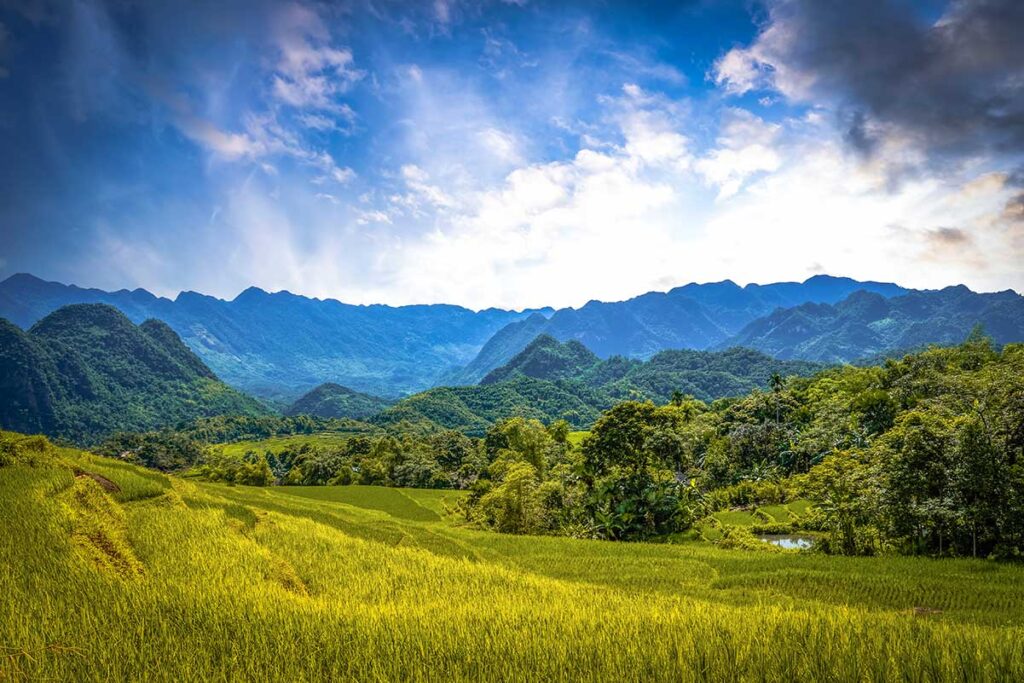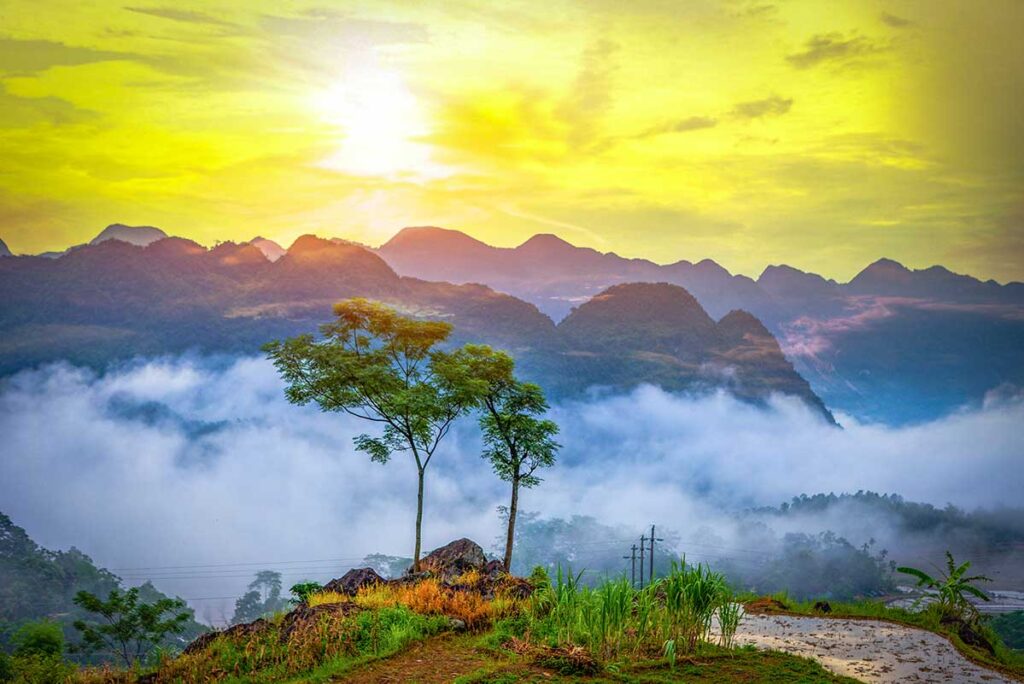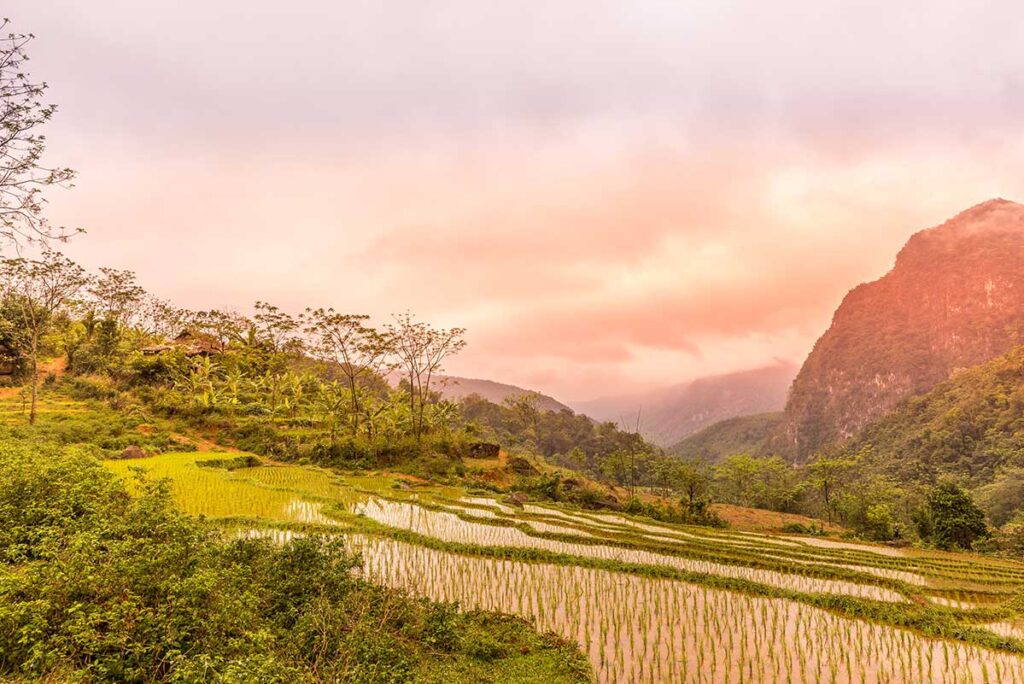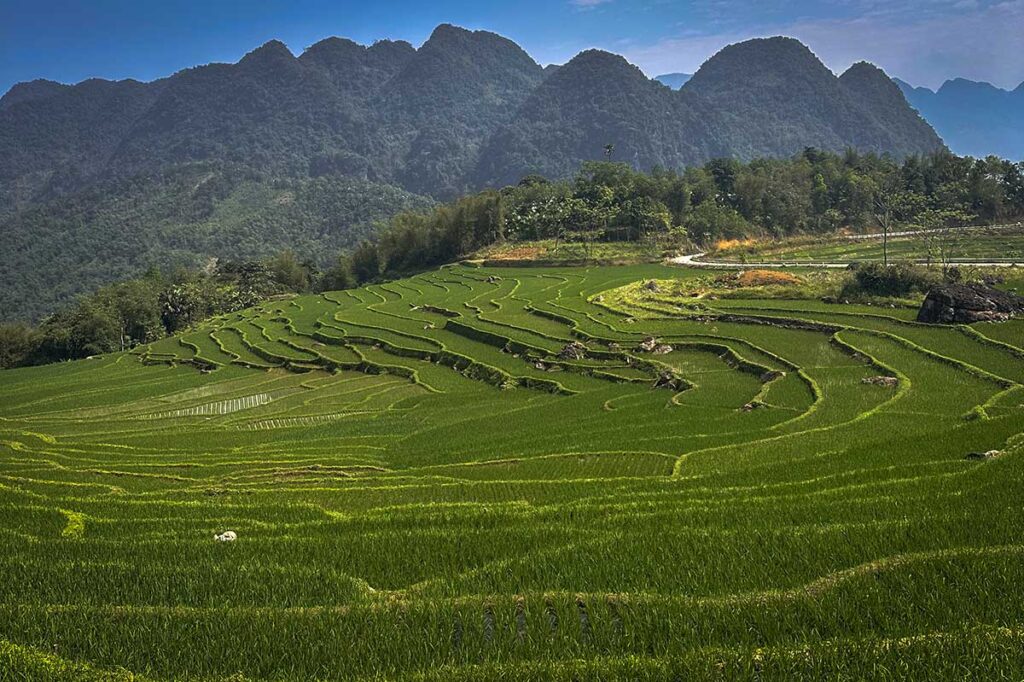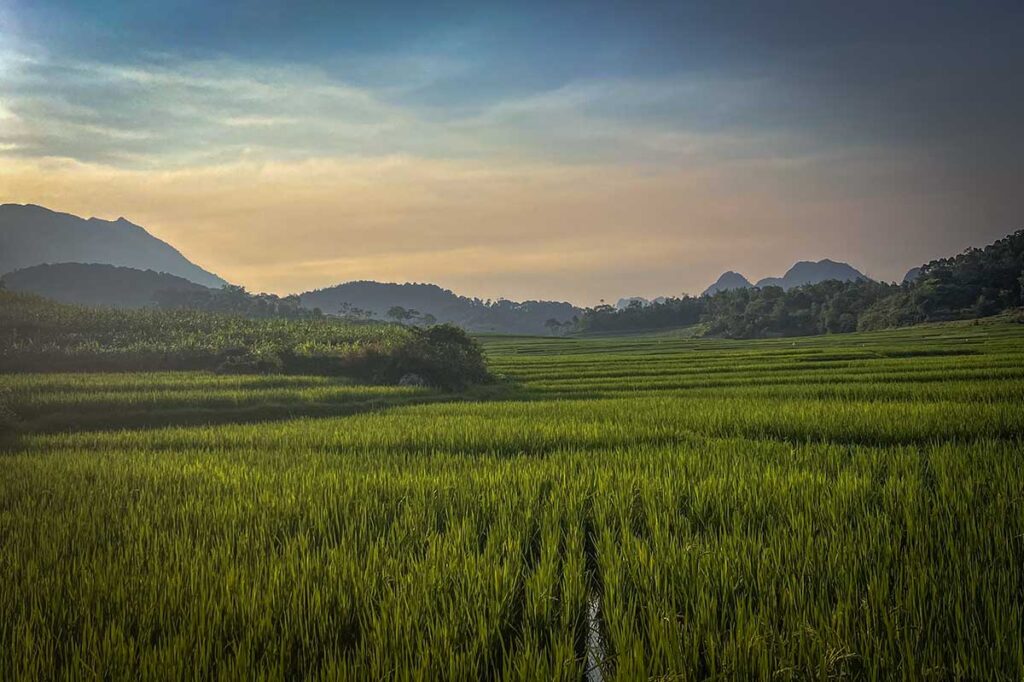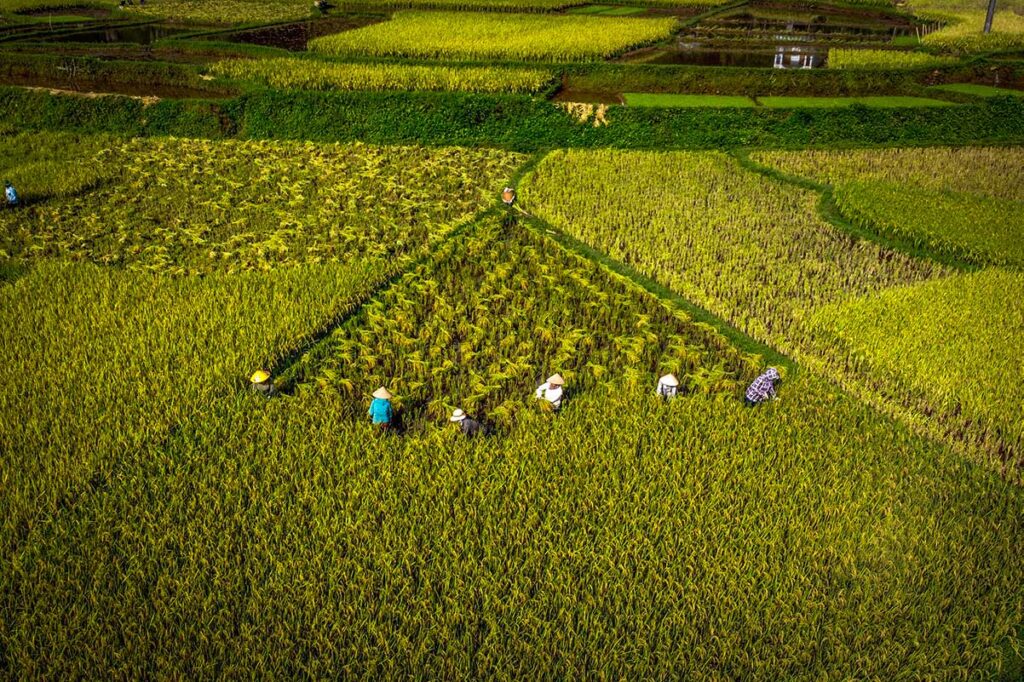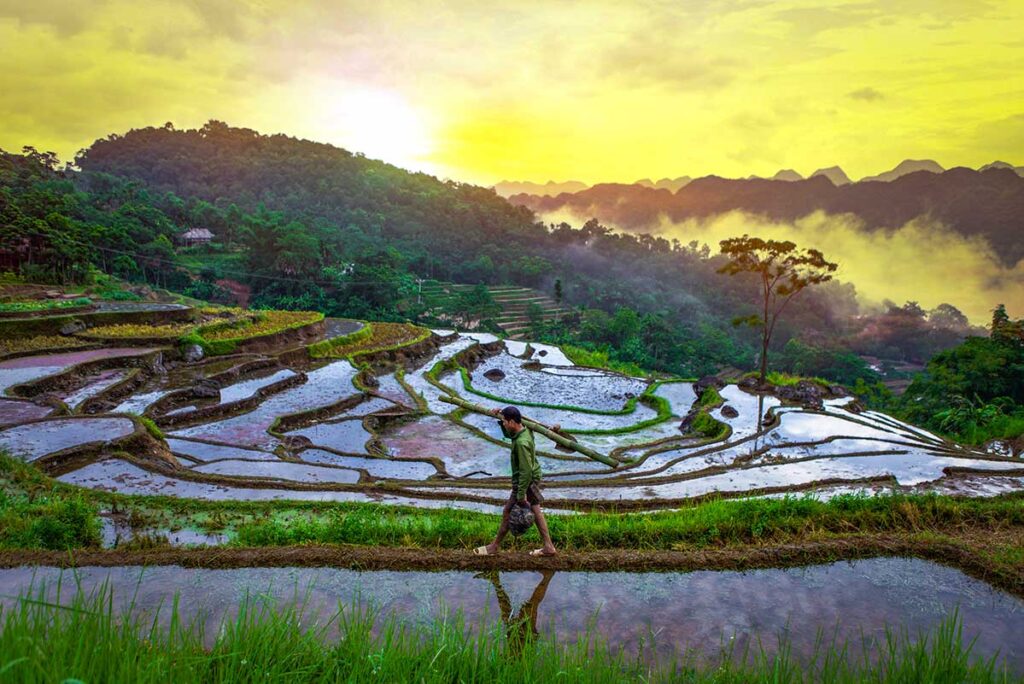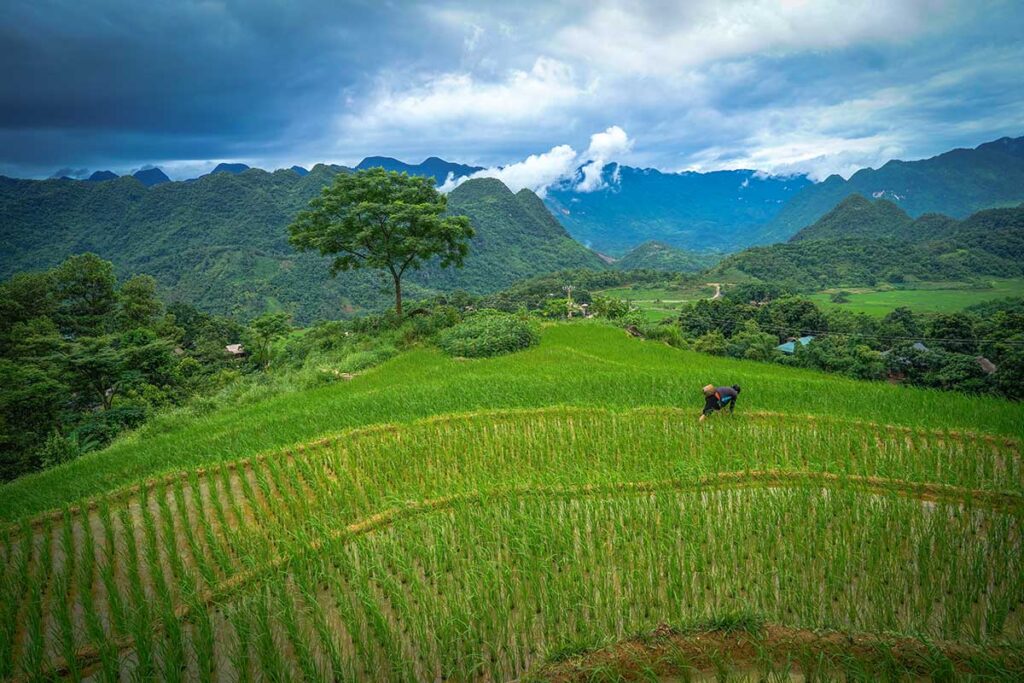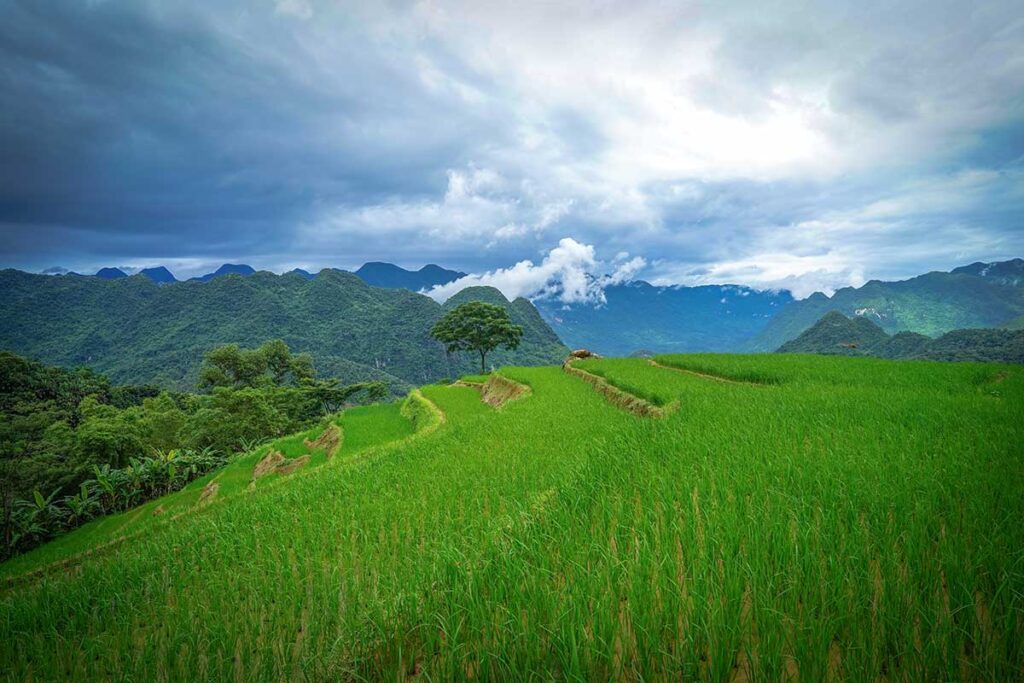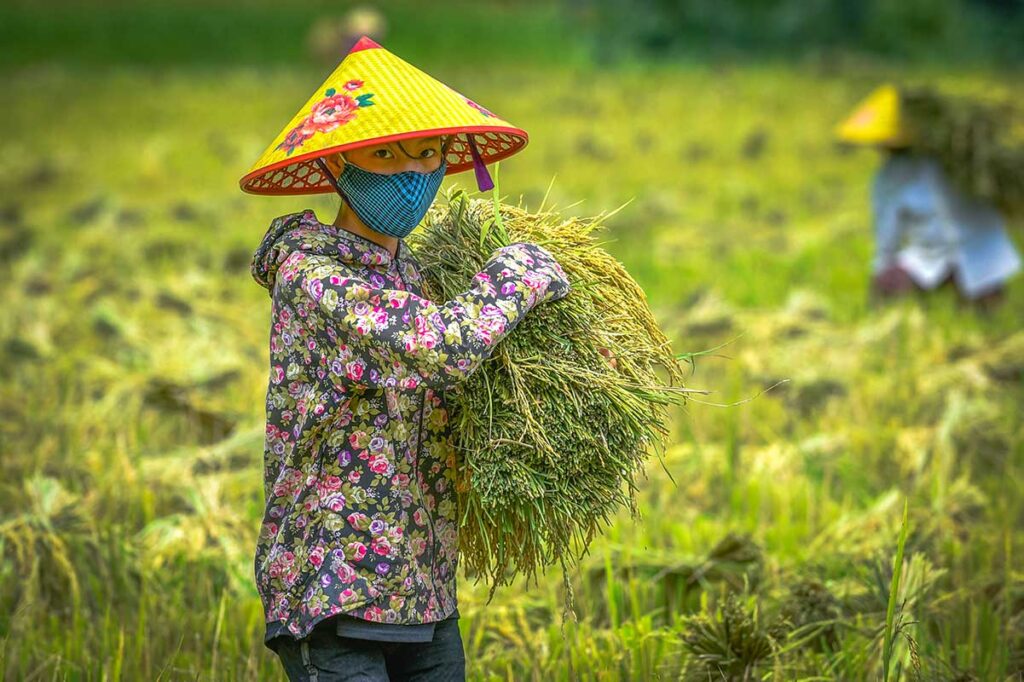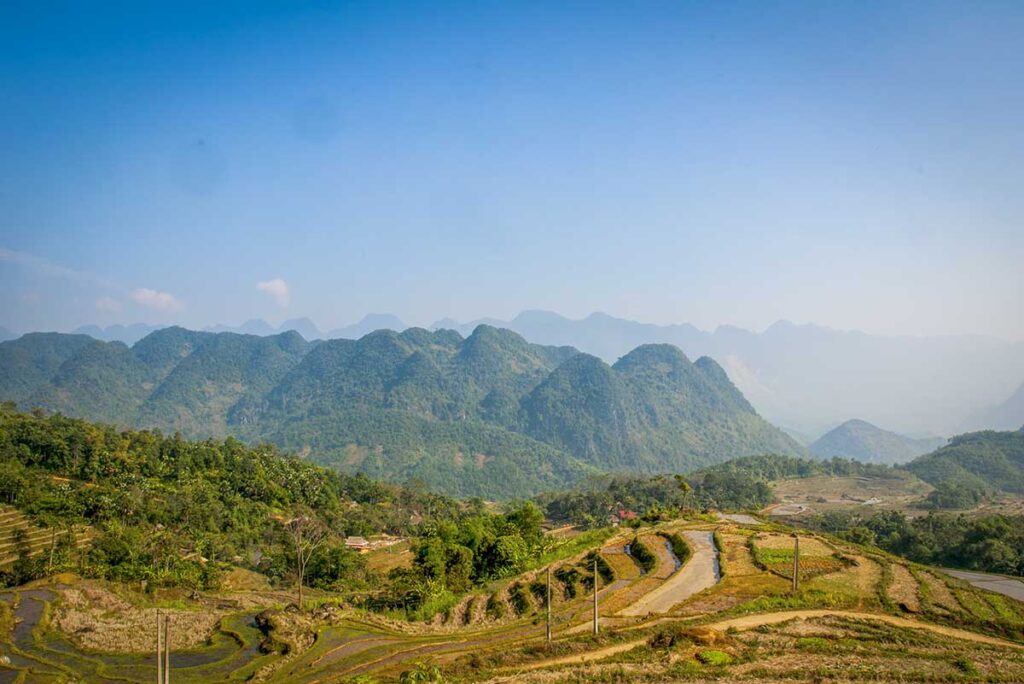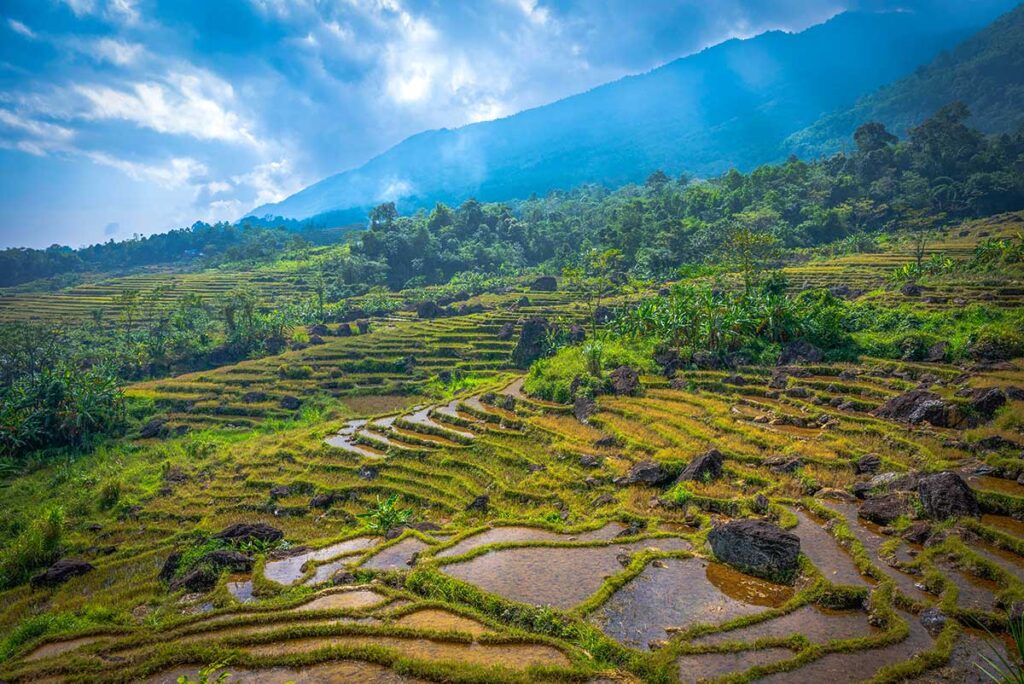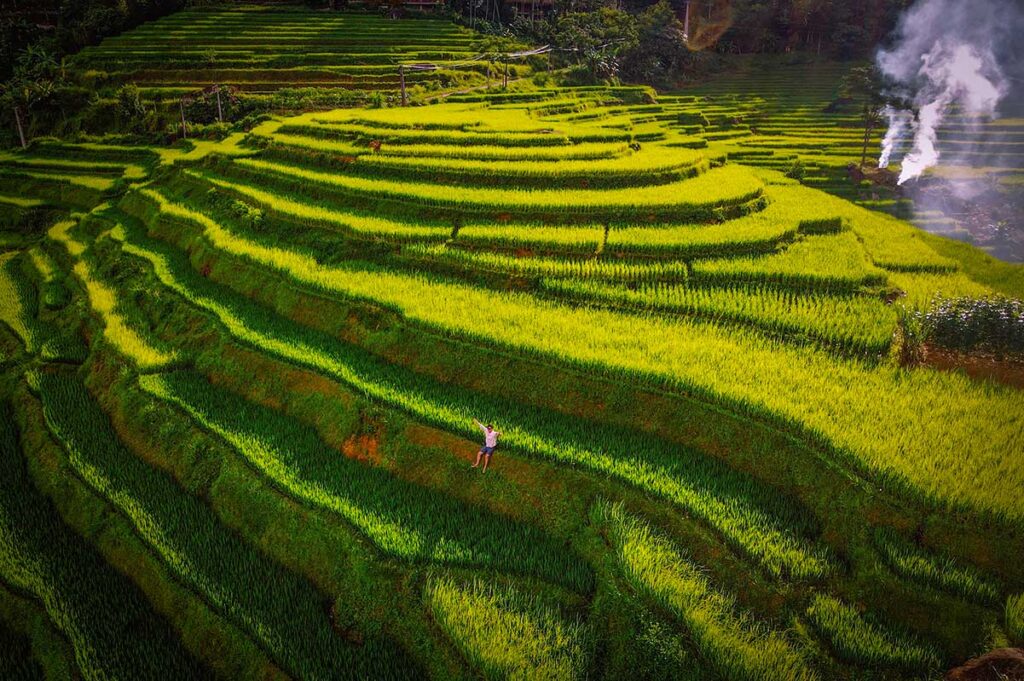Understanding Pu Luong’s climate
Pu Luong is located in Thanh Hoa Province, about 150 km southwest of Hanoi. It sits in a mountain valley, which means the weather is generally cooler than Hanoi but not as cold as higher-altitude areas like Sapa. The mix of rice fields, forests, and rivers creates its own microclimate — great for outdoor travel most of the year, as long as you time it right.
Pu Luong has two main seasons that shape the landscape and what you can do: the dry season and the rainy season.
Dry Season (October – April)
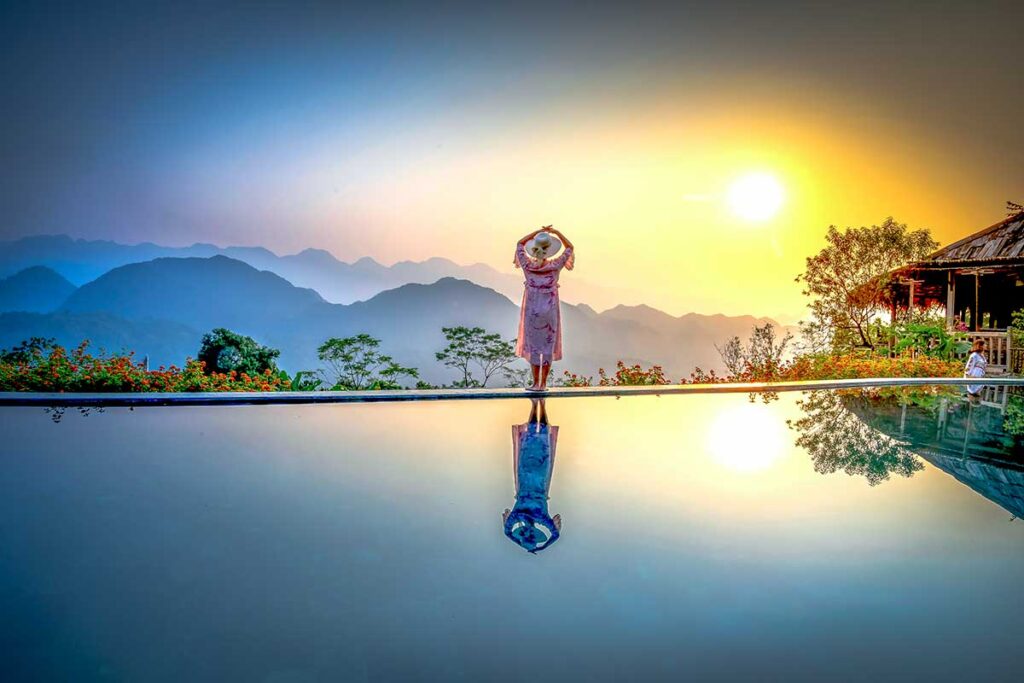
The dry season is often considered the best time to visit Pu Luong, as it is the most comfortable time to visit if you’re planning to trek, explore villages, or stay in nature lodges. Days are usually mild and clear, with daytime temperatures ranging from 18°C to 28°C. Nights can get chilly, especially from December to February, but rarely drop below 10°C. Humidity is low, and the skies are often blue.
The air is fresh, views are clear, and walking trails stay dry — ideal for hiking and sightseeing. Early in the dry season (October to November), you might still catch the end of the rice harvest, but by mid-season (December–January), the fields are empty or brown. Morning fog is common in winter, which adds a bit of atmosphere but sometimes limits long-range views for photos.
Rainy Season (May – September)
The weather in Pu Luong during the rainy season brings a dramatic change. From May onward, temperatures climb (up to 35°C in July and August), and humidity rises. You can expect frequent rain — mostly short downpours in the afternoon, but sometimes heavy and prolonged.
Trekking becomes tougher during these months. Trails are often muddy or slippery, and leeches are more common in the forest areas. However, the landscape is at its most lush and green, and waterfalls like Hieu Waterfall are at full flow — great for photos and swimming. It’s a more adventurous time to visit, and while it’s hot and wet, the scenery is incredible if you’re up for it.
Rice growing & Harvest seasons in Pu Luong
For most travelers, it’s not the weather alone that determines the best time to visit Pu Luong, but whether they can see the terraced rice fields at their most impressive. The changing shades of green and gold are what define the harvest season in Pu Luong, and those landscapes are what most people come to experience.
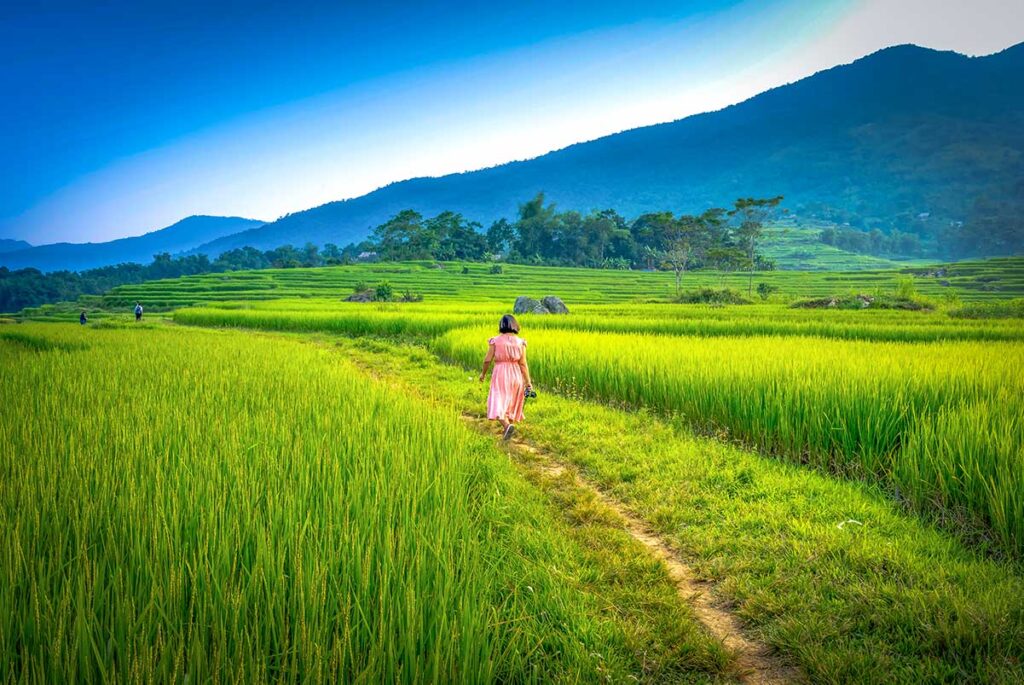
Luckily, unlike higher mountain areas like Sapa or Mu Cang Chai, Pu Luong sits in a lower valley. That means it benefits from warmer temperatures and better irrigation — allowing for two rice crops per year instead of just one. This makes Pu Luong a great place to see beautiful rice fields across more months, not just one short season.
First rice season (February – May)
The first rice season starts early in the year. Farmers begin planting in February, and by March and April, the valley is covered in vibrant green rice terraces. This is one of the best times for photography — the paddies are full, lush, and glowing under the spring sun.
By late April or early May, the first harvest begins. You’ll see locals working the fields, collecting rice by hand. While the golden harvest is stunning, the green fields in March and April are just as scenic — and they line up with some of the best weather of the year. If you’re looking for the sweet spot between scenery and comfort, March and April are excellent months to visit.
Second Rice Season (July – October)
The second cycle begins in late July, right in the middle of the rainy season. Fields stay bright green throughout August, and the rice turns golden by late September.
Late September to early October is when the harvest happens — a peak time for travelers. The terraces are at their most beautiful, and the weather is also starting to improve. If you come in early October, you might still catch some harvest scenes, but there’s no guarantee — most fields are usually finished by mid-month.
This season offers the classic golden-rice landscapes you often see in photos, especially when combined with blue skies and clear mountain air. It’s also the busiest time in Pu Luong, so expect more travelers around this period.
Best time to visit Pu Luong – Based on weather & Rice fields
The best time to visit Pu Luong depends on what you want to see and do. If you’re after the best mix of weather and scenery, there are a few months where everything lines up — clear skies, good temperatures, and stunning rice terraces.
- March: One of the most comfortable months weather-wise, and the rice fields are already green and full. Great time for trekking, photography, and village walks.
- April: Still part of the dry season, and the fields are reaching their peak. Some areas may already be turning golden.
- Late September: The start of the golden harvest season. Weather starts to improve after the rainy months, and the rice fields look incredible.
- Early October: If you’re lucky, you’ll catch the last of the harvest. Even if the rice is gone, the weather is at its best — cool, dry, and great for hiking.
Other notable months
Not every month hits the perfect combo, but a few still stand out for other reasons:
- August: It’s hot and rainy, but the rice fields are lush and intensely green. Great time for swimming, bamboo rafting, and visiting Hieu Waterfall, which is at full flow. You just need to be ready for muddy trails and afternoon rain.
- Mid to Late October: Most of the rice has been harvested by now, but this is still one of the best months weather-wise. If you don’t mind missing the harvest, it’s an ideal time for trekking.
- November: No rice fields this time of year, but the air is crisp and dry. It’s a peaceful month with fewer tourists — great if you want quiet hikes and cozy homestay evenings without the crowds.
Pu Luong weather by month
Planning your trip around the month you visit can make a big difference in what you’ll see and how comfortable your trip will be. Below is a breakdown of Pu Luong’s weather, scenery, and activity suitability for each month.
January
January is one of the coldest months in Pu Luong, especially at night. Daytime temperatures stay around 15–20°C, and early mornings can drop below 10°C. The sky is often cloudy or foggy, with only a few hours of sunshine.
There’s no rice growing during this period — the fields are dry or bare. But if you enjoy quiet trekking and misty mountain views, it’s still worth considering. It’s not the best time to visit Pu Luong for scenery, but great for peace and cooler hikes.
February
The weather in Pu Luong starts to warm up slightly in February, though mornings remain chilly and fog is still common. You may get light rain and overcast skies.
This is when the first rice season begins — farmers start preparing and planting. The fields aren’t photogenic yet, but it marks the start of the growing cycle. Hiking is possible, but trails can be damp and visibility limited.
March
March is often named one of the best times to visit Pu Luong. The weather is dry, mild (22–28°C), and ideal for outdoor activities. Skies are generally clear, and nights are cool.
Rice fields turn bright green this month, and the whole valley comes alive. Trails are in great condition, making this a top month for trekking, photography, and village stays.
April
By April, the green rice fields are close to peak. Some lower areas may even begin to turn golden by late in the month.
This is the end of the dry season, with warm but pleasant weather and low humidity — a perfect time to hike, raft, or just enjoy the views. April is a sweet spot for both the weather in Pu Luong and rice field scenery.
May
May marks the start of the first harvest season in Pu Luong, especially in the first half of the month. The scenery is still beautiful, but fields begin to empty quickly.
Temperatures rise (up to 33°C), and the first summer rains usually begin. Early May is still manageable for trekking, but the second half of the month gets more humid and less comfortable.
June
The weather in Pu Luong becomes hot and humid in June, with daytime highs often reaching 35°C. Afternoon downpours are common.
Trekking becomes more challenging — trails get muddy, and leeches are more active in the forests. Still, this is when the waterfalls are at their most impressive, and newly planted rice fields bring a fresh green look to the valley.
July
July is deep into the rainy season. Expect frequent storms, high humidity, and steamy conditions.
Rice paddies are growing fast and look incredibly lush, but trekking is hard work — trails are slippery, and rain can be unpredictable. If you don’t mind the weather, it’s good for waterfall visits or green-season photography. Be sure to pack rain gear and proper footwear.
August
August is still part of the rainy season, but temperatures ease slightly compared to July. The scenery is stunning — rice fields are at their greenest.
It’s not the best time to visit Pu Luong for hiking, but it’s a good month for relaxing, swimming, and bamboo rafting. Hieu Waterfall is usually at full flow. If you want lush landscapes and don’t mind wet conditions, this can still be a rewarding time.
September
September is when the harvest season in Pu Luong begins again. Rainfall decreases, skies clear up, and the rice starts turning golden.
By the second half of the month, the weather becomes more stable and trekking is much easier. This is one of the most photogenic times of year and often considered part of the overall best time to visit Pu Luong.
October
October is a favorite month for many travelers. The weather in Pu Luong is clear, dry, and comfortably cool (22–28°C).
The golden rice harvest is mostly finished by mid-month, but some fields may still have color early on. Trekking and cycling conditions are excellent, and the air feels crisp and fresh — ideal for outdoor travel.
November
November follows the harvest, so the fields are mostly empty or brown. But the landscape is peaceful, and the air is clear and cool.
Temperatures range from 15–25°C, and rain is rare. It’s not a scenic month for rice fields, but a great time for quiet hikes and village stays. If you value comfort over visuals, it’s still a good choice.
December
December brings cool, dry air and misty mornings. Daytime temperatures are around 12–22°C, with colder nights.
There’s no rice growing, but the views — especially in the fog-covered valleys — can still be beautiful in their own way. Great for relaxed travel, photography, and short treks, though not part of the harvest season in Pu Luong.
